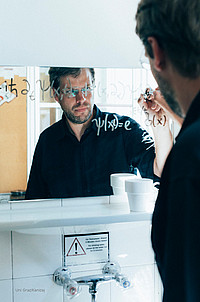Professor Axel Maas
Welcome to my research group "Non-perturbative Particle Physics Pheneomenology"
What we do
Our primary research area is to create a bridge from a fundamental understanding of quantum gauge theories to their phenomenology. The particular aim is to identify and understand phenomena, which cannot be captured with standard perturbative means, and how they manifest the genuine non-linear structure of quantum theories. Our story so far can be read in two reviews articles, on Brout-Englert-Higgs physics: From foundations to phenomenology and Gauge bosons at zero and finite temperature. A popular science description of this research can also be found in our blog. The latest news on our research or from the field can also be found on Twitter.
Foundations of quantum-gauge-field theories
So-called gauge theories represent the most common version of particle physics theories. Especially the standard model, but also gravity, and most of their speculated extensions belong to this category. While they have been extremely successful in the description of nature, several very fundamental issues of them are still poorly understood.
One of them is what their physical degrees of freedom are, and how they emerge from the fundamental ones. This entails especially the question of how the mathematical structure is related to the physically observable one. The complex geometric structure of gauge theories made this a challenging problems since more than half a century.
Our aim is to explicitly construct physically observable particle spectra. Likewise, we determine how they are made up from the elementary degrees of freedom, and what kind of mathematical-geometrical structure governs their relation.
Standard model physics
The discovery of the Higgs boson has been one of the greatest scientific discoveries of the recent years. It is the last element of the standard model of particle physics, and a possible gateway to whatever lies beyond. With this discovery, the properties of the Higgs came into the focus of investigations.
The theory underlying the Higgs sector has plenty of enigmas so far. One is that it is not even clear, whether it a real theory, or whether new physics is mandatory to make it a real theory. The other is that there are subtle effects which are not yet accounted for, but which could provide distinct new signatures, like states containing several Higgs bosons or deviations from expectations in experiments.
To fully understand Higgs physics, we investigate and simulate numerically electroweak, Higgs, flavor and top physics in the standard model. We determine signatures for the LHC and future colliders. We furthermore use our understanding of gauge theories to infer how Brout-Englert-Higgs physics work.
Unifying interactions
The standard model has a very peculiar, regular structure. This suggests the existence of an underlying ordering principle, a unifying theory. We expect that such a unifying theory needs to involve the Brout-Englert-Higgs effect to create the apparent independent known interactions, the electromagnetic one, the weak one, and the strong one.
We therefore study how generalized Brout-Englert-Higgs effects act, and how they can help to shape both the known interactions and the flavor structure of the standard model. Especially important are here how the spectrum of known particles emerges in the process. This not only includes known particles, but also dark matter.
Finally, it is not clear how a quantum theory of gravity can factor into this picture. We therefore study how gravity and the Brout-Englert-Higgs effect interact, and also supersymmetry as a possible unifying concept of particle physics and quantum gravity.
